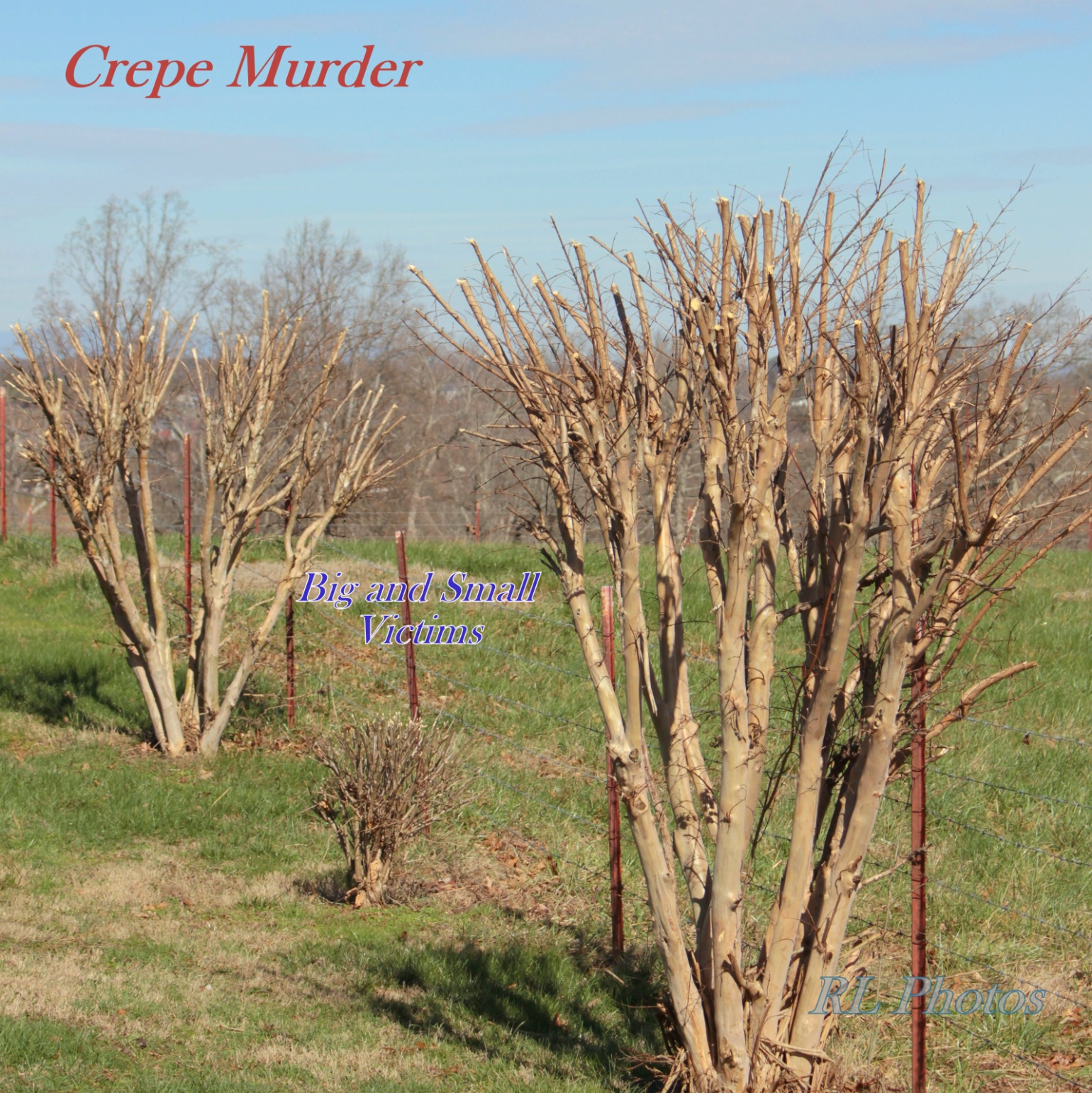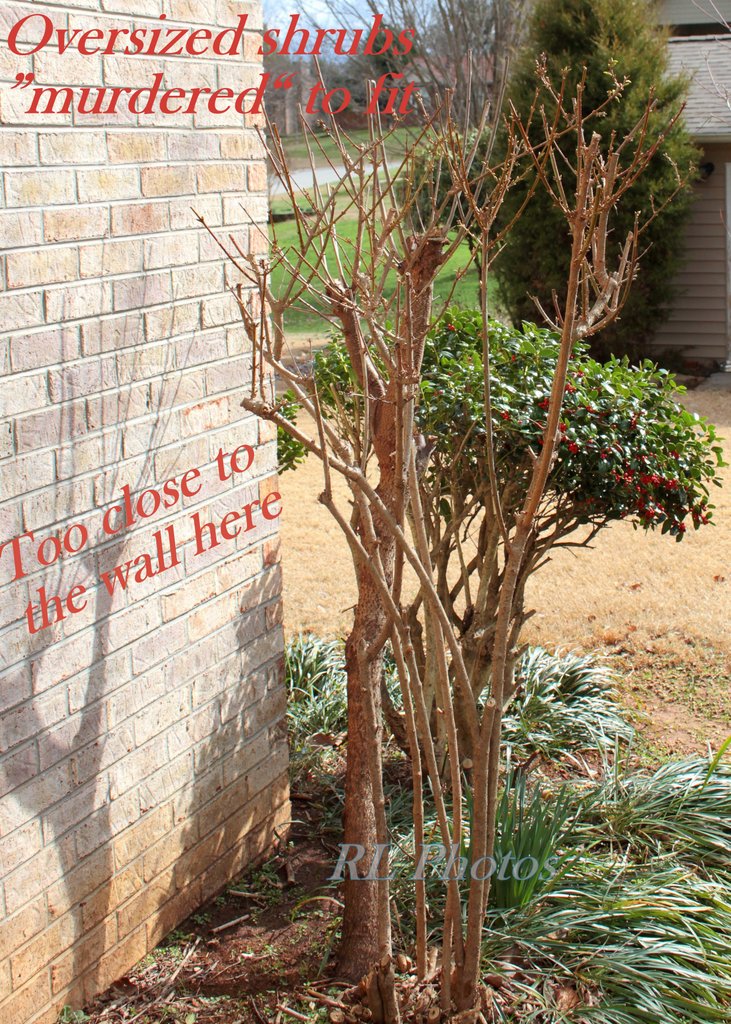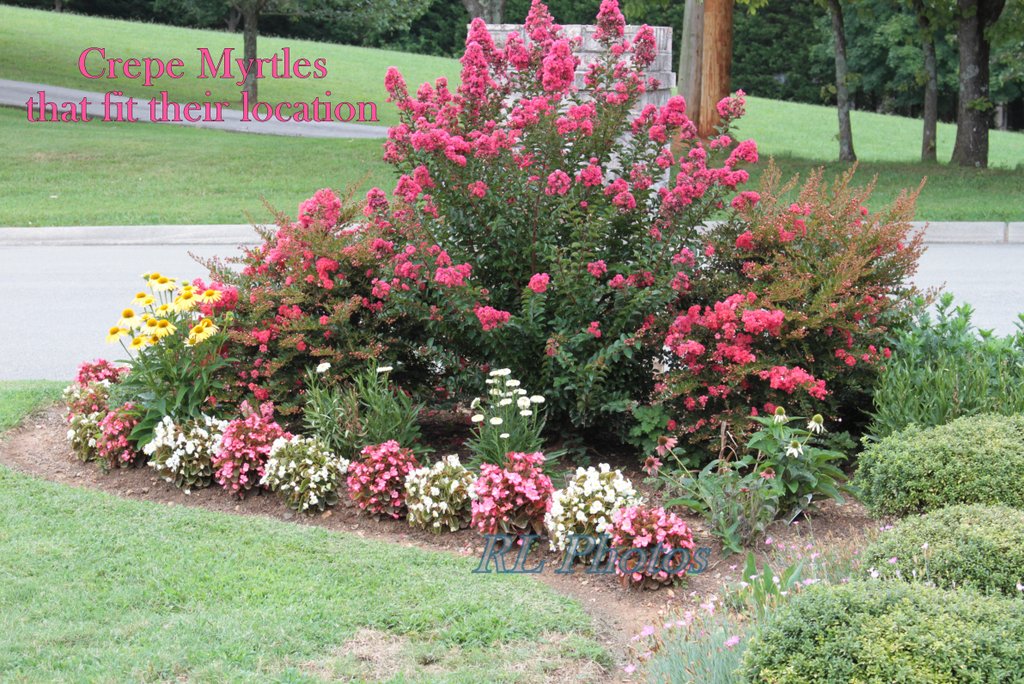Crepe Murder
Every year crimes against nature are committed in gardens all across the South. Some are done by well meaning gardeners and homeowners who copy what they see others do. As a child, I was admonished by my father for some poor choices with "Would you jump off a cliff because everyone else is doing it?" This crime falls in the same poor choice category! There just aren't valid reasons to do it, but everyone else does it. Often this green crime is carried out by ignorant "landscape" companies in possession of freshly sharpened chainsaws, and with the need to get the job done quickly. Or maybe you noticed a neighbor with spring fever and a shiny new chainsaw out there hacking away? The results are hideous and deformed trees whose lives are being shortened. We've all seen these unfortunate knobby looking trees with a few shortened limbs left trying hard to grow a few new green leaves. By the summer, they give a last ditch effort to bloom and leaf out. The lovely crepe myrtle is reduced to a stunted shadow of what it could be. Instead of graceful sturdy limbs, it sprouts lots of small and weak branches flopping downward with the few flowers it manages. These little branches are sometimes referred to as water sprouts, and they will never make strong limbs. Plus, they're prone to further damage. Water sprouts (on any tree) are a last gasp attempt by the tree to grow leaves to make the energy required to live. It isn't beautiful when done to any tree but, for some strange reason crepe myrtles, the prettiest tree in the south, gets by far the worst repeat punishment. What is the right name for the tree? What is the right name for these pretty trees I see blooming all over the south in the worst heat and humidity? The Crepe Myrtle (its Latin name is Lagerstroemia) is called by many similar names. The primary authority, the Crape Myrtle Society of America obviously calls it "Crape Myrtle". Southern Living publications call it "Crepe Myrtle", and several well known authorities on all things plants refer to them as "Crapemyrtles", and a few more call them "Crepemyrtles". Very few plants or trees have so many common names that even the experts can't agree! For consistency I've gone with the Grumpy Gardener of Southern Living, one of the biggest crusaders against Crepe Murder, and will be calling them Crepe Myrtles for this article.
Many people seem to be under the sadly mistaken impression that in order for Crepe Myrtles to bloom well they need to be cut back to their central limbs every year. Seeing professionals (and I am using that term very loosely) at commercial establishments, like the local gas station and bank, haul out the chainsaws at the end of winter and whack down the already deformed and shortened crepe myrtles once more makes the average home owner believe this is proper crepe treatment. Let's all jump off of that cliff! Repeated butchering can result in the eventual death. More often it is a slow descent into lack of blooms and horrible deformity. The tree does not naturally form "knuckles" at the top of its stems. It is ugly in winter and afterwards the trees don't bloom as profusely. If they do bloom, their branches break more easily. On top of that, in late fall and winter, the beautiful shedding bark often not as pronounced or completely absent. This slow death and deformity has been coined as Crepe Murder.
- Plant the Right Size for the Right Place One reason many people give for Crepe Murder is trying to keep the tree "in check" or "cut down to the right size," both of which are horrible reasons for annual tree butchery. It would be far better to remove a tree that is too big and start again with one that is going to mature to fit its place in the landscape. There are plenty of dwarf and shorter crepes out there. These trees will get no bigger than 10 -15 feet. In fact, there are now ground cover varieties as well as small and medium sized shrubs. The shrubs are making an excellent replacement for my Knockout Roses which have sadly succumbed the scourge of Rose Rosette disease. The picture shows how nicely these smaller Crepe Myrtles can fit in any sized garden. A good start to finding the right tree for your space is the United States National Arboretum website table on Crape Myrtles: http://www.usna.usda.gov/PhotoGallery/CrapemyrtleGallery/CrapeTable.html
Another great source for both color and height is from the Texas cooperative extension: http://aggie-horticulture.tamu.edu/databases/crapemyrtle/crape_myrtle_varieties_byheight.html This series divides the heights from the smallest to the largest, most have color pictures of the blooms and a brief description of the tree shape. What makes this list extra useful is that they also list mildew resistance. Many of the older varieties of Crepe Myrtle were often stricken with mildew, where as many newer ones have been bred with resistance. Clemson also has an older page devoted to Crepe Myrtles that is more limited and not as up to date. It is, however, easy to print and take along when you shop, and you can use it as a template to make your own list: http://www.clemson.edu/extension/hgic/plants/landscape/trees/hgic1023.html Crepe Myrtles are generally hardy in our mostly zone 7 area. For those in our area living a little higher in the mountains, you should look for varieties with a little more cold hardiness to at least Zone 6. The following page also notes cold hardiness along with other important traits: http://www.ag.auburn.edu/landscape/crapemyrtle2.htm - Light Prune for Shape Not Height Most guides to general pruning will tell you to trim little - cut only cross branches or to correct deformities. This goes even more so for Crepe Myrtles which generally grow well without human intervention. When you're standing in front of the tree with loppers, pruners and tree saw in hand, exactly what to prune isn't always easy to see! One of my favorite versions of how not to commit Crepe Murder is from the Grumpy Gardener. That's Southern Living's Steve Bender who, despite his name, is really quite nice. Grumpy has been in the forefront of the fight to educate people about the damage being done with the butchery of Crepe Myrtles. A few years ago he put up a beautiful description with some photos that are quite helpful for the DIY pruner: http://thedailysouth.southernliving.com/2009/02/24/what-concerns-p/
Fixing Crepe Murder If you've been guilty of Crepe Murder, or just inherited some badly mutilated trees, there is some hope. With patience and a multiyear plan, you should be able to get your Crepe Myrtles back into decent shape looking like they should. First you need to brutally honest and decide whether or not each tree has been planted in the wrong place and needs to be removed rather than rehabilitated. In severe cases, you may need to cut off the large knobs. Otherwise, just remove inward growing and crossing limbs, as well as suckers and very low branches. Over a period of a few years, the trees will begin to look like they should! Grumpy Gardener has a great guide here: http://thedailysouth.southernliving.com/2015/04/09/how-to-fix-crepe-murder/ |


 Please Stop Killing Your Trees!! - by R. Lieber
Please Stop Killing Your Trees!! - by R. Lieber What exactly is Crepe Murder?
What exactly is Crepe Murder? How To Have a Healthy Crepe Myrtle
How To Have a Healthy Crepe Myrtle This table has a description of everything from height to bark, and describes autumn leaf color as well as flower color. Many of the varieties in the table are clickable, taking the visitor to a page with pictures of the tree and the listed descriptions and an additional printable fact sheet.
This table has a description of everything from height to bark, and describes autumn leaf color as well as flower color. Many of the varieties in the table are clickable, taking the visitor to a page with pictures of the tree and the listed descriptions and an additional printable fact sheet. Note the "before" and "after" photos taken in the garden of a fellow Master Gardener, and see how little Crepe Myrtles really need to be pruned to maintain a healthy shape. Pruning should be done to cleanup crossed branches and any lopsided growth following weather damage. While not necessary, many gardeners will also trim off any old seed pods. Later in the year after the first blooms begin to fade, you can cut these green seed pods and often be rewarded with additional
Note the "before" and "after" photos taken in the garden of a fellow Master Gardener, and see how little Crepe Myrtles really need to be pruned to maintain a healthy shape. Pruning should be done to cleanup crossed branches and any lopsided growth following weather damage. While not necessary, many gardeners will also trim off any old seed pods. Later in the year after the first blooms begin to fade, you can cut these green seed pods and often be rewarded with additional blooms to stretch the bloom period a tiny bit more.
blooms to stretch the bloom period a tiny bit more.